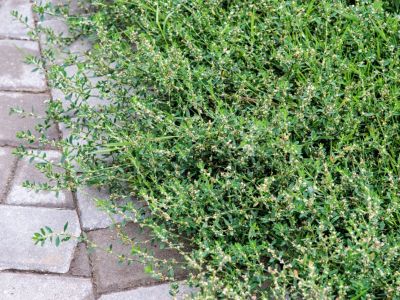How much do you know about knotweed types or even about knotweed identification? Do you know how to kill knotweed? What’s the best method of knotweed control?
Knotweed Identification
Knotweed is a short-lived perennial that grows from a central taproot to spread its wiry stems outward in a dense mat of wiry stems that are broken by small joints or knots. Those stems are covered with small, blue-green leaves growing alternately from base to tip. There are two common knotweed types.
Common or prostrate knotweed, or Polygonum arenastrum, also known as wiregrass, wireweed, matweed, or doorweed grows flat, spreading outward in a dense circular form that can reach 18 inches (46 cm.) across with a narrow taproot that can grow as deep. It rarely reaches more than a few inches (8 cm.) tall. Polygonum argyrocoleon or silver sheathed knotweed grows more erect to a height of one foot (31 cm.) or more. It has long rose colored flowered spikes.
Many gardeners confuse garden spurge with knotweed. Identification is easy when you remember the spurge exudes a milky substance when broken and knotweed does not. Unlike most types of weed, knotweed prefers dry, hard packed soil. It is found in areas of the lawn that see the greatest foot traffic, along paths, between stones, and growing in the cracks of sidewalks and driveways. It is also found in turf under stress.
Tips for Knotweed Control
In turf grasses, knotweed control isn’t only about how to kill knotweed. It’s about growing strong healthy turf that never allows the weed to take hold. Well aerated and well fertilized lawns make it difficult for knotweed to take hold. Think about setting stone or gravel walkways where foot traffic is heaviest. Pre-emergent herbicide treatments are most effective while most post-emergent home lawn treatments have little effect. Once either of the knotweed types is established, spot treatments work best. In other areas, knotweed control is mostly a matter of killing it early. Common knotweed seed germinates in the heavy rains of spring. Its long taproot helps it survive the dry heat of summer. Granular treatments that prevent seeds from germinating will help stop most weed growth, but once the seed sprouts, spot treatment sprays are most effective. Pulling the weeds or treatment with many of the organic solutions will only provide a temporary solution. That same taproot that enables the plant to survive drought also enables it to regrow if only a small part of it survives. Treatments will be most efficient in the spring and early summer while the plant is most tender and vulnerable. Common knotweed isn’t the worst weed to have in your yard, but it can be one of the most aggravating. It tends to grow in areas where nothing else will and takes over while your back is turned. With a little knowledge and a lot of vigilance, knotweed control is possible.
